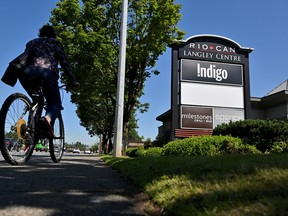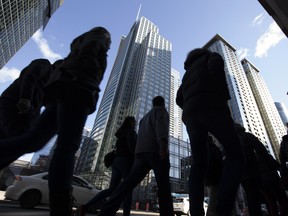REITs have reasons for optimism despite a darkening economic picture

Parts of landscape should remain resilient, even if rising prices, rapid monetary tightening throw Canada into a downturn

Article content
Canada’s commercial real estate companies saw positive leasing momentum, strong rent collections and stable occupancy as they continued to battle back from the pandemic during the first half of 2022. Now the question is whether they can keep that trend going in the face of rising inflation and a potential recession.
Advertisement 2
Story continues below
Article content
While Canada has so far been able to outrun the worst of the forces buffeting the global economy, a disappointing GDP print that showed slowing growth in Q2 and an early reading of a contraction in July suggests the country’s luck might be running out.
Article content
But some market watchers suggest at least parts of the REIT landscape should remain resilient, even if rising prices and rapid monetary tightening throw Canada into a downturn.
A report from CIBC Capital Markets in June noted that REITs appear well-positioned to handle rising rates into 2026 for a number of reasons, including the ongoing return to pre-pandemic operational performance and the way REITS tend to structure their debt, with only a portion rolling over and being subjected to potentially higher rates each year.
Advertisement 3
Story continues below
Article content
In its Q2 real estate outlook, meanwhile, global real estate services firm Jones Lang LaSalle Inc. predicted that different segments of the REIT universe would hold up better than others if the economy worsens.
“Both industrial and retail are expected to remain resilient to softening economic conditions as the year wears on,” the report said. “Office, however, is expected to experience a delayed recovery from COVID-induced occupancy losses.”
Both industrial and retail are expected to remain resilient to softening economic conditions
Jones Lang LaSalle
The outlooks came after a generally strong quarter across the board.
Industrial outperforming
Industrial real estate markets continued to experience strong demand, with warehousing and fulfilment ranking as the top investments and inventories remaining extremely limited across Canada, according to PricewaterhouseCoopers (PwC).
Advertisement 4
Story continues below
Article content
The rapid rise of e-commerce has been the biggest driver of growth on the industrial side. Trends, such as bidding wars, more typically associated with other asset classes are increasingly becoming factors in the space. There has also been a significant crossover and blurring of lines between industrial and retail markets as the “last-mile” delivery of e-commerce goods brings industrial facilities closer and closer to end-use consumers.
According to JLL’s report, leasable industrial space is expected to remain in short supply in the coming quarters. While industrial sales may begin to see a significant shift downwards with rising interest rates, so far, sales and performance have remained robust.
Granite Real Estate Investment Trust and Granite REIT Inc., for example, posted net operating income (“NOI”) of $92.8 million in the second quarter of 2022, up from $80.3 million in the prior year period.
Advertisement 5
Story continues below
Article content
Retail evolution
On the retail side, landlords continue to adapt to post-pandemic realities, and are looking for new ways to bring value to their tenants, such as by sharing data and offering more diverse experiences.
RioCan chief executive Jonathan Gitlin said his company has sought to help retailers reconfigure their stores and environments as shopping preferences shift.

“We’re helping our tenants evolve the space, whether it’s by changing the way drive aisles are set up in the parking lots … or if it’s changing the way loading works, or if it’s changing the way signage works. We’re doing things to help our tenants open up again and thrive,” he said.
It’s one of the tactics that has the company confident it can withstand any turbulence inflation might inflict on the retail sector.
Advertisement 6
Story continues below
Article content
RioCan saw committed occupancy improve for the sixth consecutive quarter in the second quarter, returning to a pre-pandemic level of 97.2 per cent.
JLL noted that confidence remains high on both sides of the retail equation, auguring well for the sector.
“Businesses are confident about increased sales and shoppers are largely confident about spending,” the JLL report said.
End of the office party?

Office space, on the other hand, has been the laggard of the group, and could be most susceptible to a downturn.
After a slow rise in national vacancies over the past three quarters, the rate jumped 40 basis points in Q2, to reach 14.7 per cent.
Vancouver continued to lead the pack with the lowest vacancy rate in North America at 7.3 per cent. At the other end of the spectrum, Calgary checked in with a 26.8 per cent vacancy rate, though that’s still down from a high of 27.3 per cent experienced in late 2021.
Advertisement 7
Story continues below
Article content
To respond to some of these challenges, landlords have offered support to those tenants looking to reconfigure their offices to incorporate more room for collaboration and team meetings. But at the first hint of a recession, “several companies began second-guessing their real estate decisions,” according to JLL.
-

Why Ottawa’s rent-to-own program won’t do much to solve Canada’s housing woes
-

Rent scams are on the rise, and students are particularly vulnerable
-

Estimates differ, but planners should never forget that more housing construction is needed
“Some tenants opted to sign termination agreements with the landlords, especially those reducing their headcount or shelving their growth plans for the time being. While this can be a pricey option upfront, the alternative of under-using their space could be much more costly still,” the report said.
Advertisement 8
Story continues below
Article content
Overall, the REIT market experienced a net rental rate drop quarter-over-quarter, except in Montreal, which saw a 5.4-per-cent increase in overall average net rental rates. The downtown Toronto market saw the most significant decrease, dropping just over four per cent quarter over quarter to $36.92 per square foot from an average of $38.44 in Q1. The national average hit $20.22 in Q2, a 1.5 per cent decrease relative to the $20.52 average in Q1, a historical high.
Market watchers will be monitoring to see if that softening continues amid the economic headwinds.
• Email: [email protected]
Advertisement
Story continues below








